Integrating machine learning models into analytics pipelines allows organizations to leverage the power of data-driven insights and predictions in their decision-making processes. Here’s an overview of the steps involved in integrating machine learning models into analytics pipelines:
- Define the Objective: Clearly articulate the problem or objective that the machine learning model aims to solve within the analytics pipeline. Identify the specific use case, desired outcomes, and the role of the model in the overall analytics process.
- Data Collection and Preprocessing: Collect and preprocess the relevant data required for model training and inference. This may involve data cleaning, feature engineering, handling missing values, and scaling or transforming the data to make it suitable for the model.
- Model Training and Evaluation: Train the machine learning model using the prepared data, following the steps mentioned earlier in the model training and evaluation section. Assess the model’s performance and choose appropriate evaluation metrics based on the problem domain.
- Model Integration: Integrate the trained model into the analytics pipeline to make predictions or generate insights. This can be achieved using various methods, including:
- Batch Processing: Perform offline predictions on a batch of data, where the model processes a set of input data and produces predictions or outputs in bulk. This is suitable for scenarios where real-time predictions are not required, such as periodic reports or data analysis.
- Real-time Processing: Incorporate the model into a real-time analytics pipeline, where it processes incoming data streams and provides immediate predictions or insights. This can involve setting up a streaming data processing system, such as Apache Kafka or Apache Flink, and integrating the model within the pipeline.
- API Integration: Expose the trained model as an API (Application Programming Interface) endpoint, allowing other systems, applications, or users to send requests and receive predictions or insights in return. This enables easy integration with different platforms or frameworks and facilitates model consumption by other applications or services.
- Error Handling and Monitoring: Implement error handling mechanisms and monitoring processes to ensure the smooth functioning of the model within the analytics pipeline. This includes handling exceptions, logging errors, and setting up alerts or notifications for potential issues or failures.
- Performance Optimization: Fine-tune the model’s performance within the analytics pipeline by considering factors like computational efficiency, latency, and resource utilization. Techniques like model optimization, model compression, or hardware acceleration can be employed to improve efficiency and reduce inference time.
- Continuous Improvement: Monitor the model’s performance over time, collect feedback, and iteratively improve the model by retraining or fine-tuning it as new data becomes available. This helps maintain the model’s accuracy and relevance in evolving business environments.
- Documentation and Version Control: Maintain proper documentation of the integrated model, including details about the dataset used for training, preprocessing steps, model architecture, hyperparameters, and evaluation results. Employ version control techniques to track changes, facilitate reproducibility, and ensure consistency across different versions of the model.
By integrating machine learning models into analytics pipelines, organizations can automate data analysis, gain insights at scale, and make data-driven decisions based on predictions and recommendations derived from the models. It enables the seamless incorporation of machine learning into existing analytics workflows, enhancing the value and impact of data-driven initiatives.
SHARE
